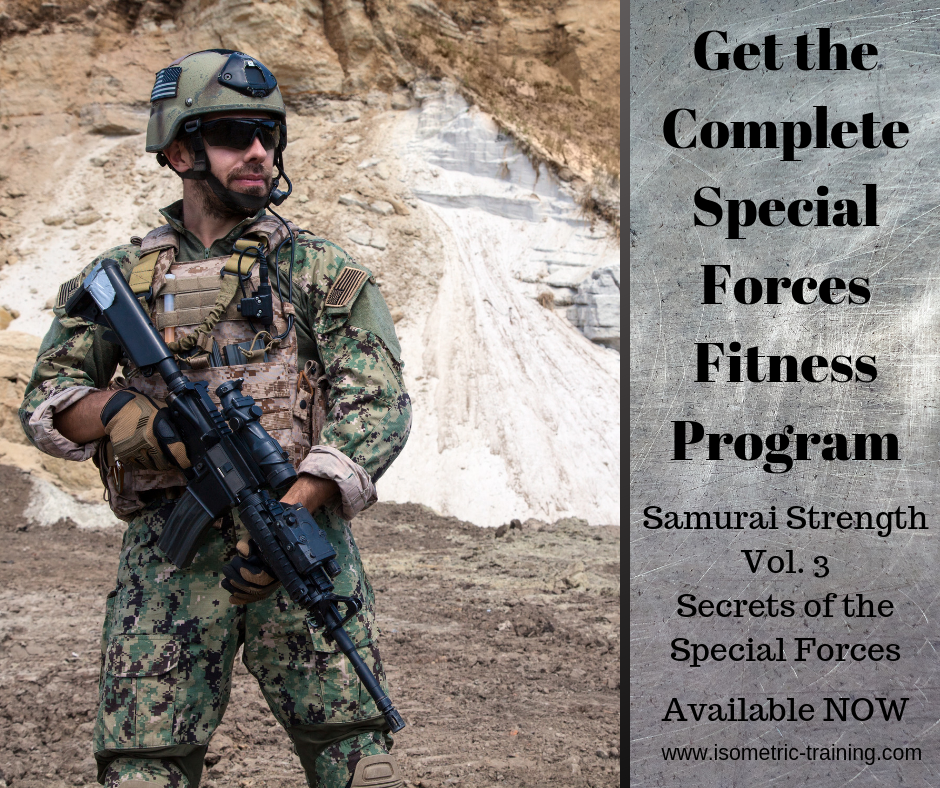How Batman Would Train Captain America...or How to Pass the Army Fitness Test
By Paul "Batman" O'Brien
B.A., N.C.E.H.S., Dip. Acu., Cert Clin. IMed., Dip. Adv. OBB, Dip. CHM, Pn1, PN-SSR, PN-NCA, M.AFPA., M.C.Th.A.

How Would I train Captain America...or How to Pass the New Army Fitness Test? I’m going to answer that by giving you two complete workouts that will allow you to do this at the end of this article and then give you my primary recourse for achieving a Special Forces level of fitness. But first...why...what’s changed?
The Old - The Army Physical Fitness Test (APFT)
Well, starting in the 1980’s America’s soldiers have been ranked for their physical readiness to deal with the demands of war, via the Army Physical Fitness Test (APFT). As originally conceived, the APFT consisted of a two-mile run for time, a maximum number of push-ups completed in two minutes, and maximum number of sit-ups completed in two minutes.
The test was administered during the initial entry of a soldier into the United States Army and then there would be a unit based retest (most often at a platoon level) every 6 months. In addition there would often be other physical testing conducted during deployment and in combat zones, where details of the tests would be mission orientated. These tests, however, did not contribute to the fitness record of a soldier, only the 6 months reviews.
And the Special Forces Units have other requirements. The US Navy SEALS, for instance, have to swim and do pull-ups. . ;-)
The New - Army Combat Fitness Test (ACFT).
An elite soldier needs to multiple fitness attributes to deal with long term military engagement. They needed endurance for long marches with heavy equipment. They need to maintain muscle tension without fatigue for prolonged periods of time in total stillness. They need to be able to carry fellow comrades in arms, with both their gear on. They need to be resistant to injury. This requires strength, physical endurance stamina, and flexibility.
And the fitness readiness test of the US Army; a run, some pushups and some sit-ups is woefully inadequate. That is set to change October 2020, as soldiers will then be required to take the new Army Combat Fitness Test (ACFT).
This new test is far more comprehensive and reflective of the demands placed upon a soldier. It assesses power, absolute strength, and anaerobic conditioning. Better still, the ACFT is gender-neutral. There is no discrimination in performance and output between females or males. The standard is the standard.
If you’re considering enlisting you need to know these exercises and how to train for them. If you’re not planning to serve in the military I consider these the basic requirements of functional fitness and an excellent method of scoring and assessing fitness. It is also the base standard of fitness I expect of my clients.
Captain America's 6 Fitness Exams
The Army Combat Fitness Test (ACFT) consists of 6 components.
- Trap-Bar Deadlift - this is testing Max Strength. You have 2 attempts to establish a 3RM and then to score a passing grade of 70, need to lift 180 lbs x 3, and to score 100 lift 340 lbs x 3. This is required for soldiers as artillery shells are damn heavy as is an M2 .50 calibre machine gun. Then there is the 100 pounds of gear and body armour you’ll be wearing while mounting a wall.
- 2. Ball Throw - this is testing Explosive Power (Fast Twitch Muscle Fibre Capacity). For this test, you have to throw a 10 lbs medicine ball over and behind your head. To pass with 70 the ball needs to travel at least 8.5 meters. To score a perfect 100, the ball must travel at least 13.5 meters. This is need for throwing grenades, vaulting over a ditch, kicking down doors, punching some real hard, throwing an opponent, etc.
- Hand-Release Push-Up - this is testing either upper body endurance or strength depending on fitness levels. You have to do as many as possible in two minutes, if you can do at least 30, you get a passing score of 70. If you can do at least 70 you get a score of 100. If you have a good level of strength, then this is about endurance. If you aren’t strong then this becomes about strength.
- Drag Test - this is testing anaerobic conditioning. For this test, you sprint 25 meters, drag a 90 lbs sled 25 meters, side shuffle 50 meters, and then carry two 40lbs kettlebells 25 meters, all for time. To score the minimum pass rate of 70, you need to complete this in 2:09 min. To score the max of 100, you need to complete this in 1:40 min. This is a brand new drill for the Army (but one that’s been in events like Hell and Back, for donkey’s years), but this is great for simulating realistic battlefield conditions, like sprinting for cover, dragging someone to safety, or carrying ammunition 50 meters to the front.
- Leg Tuck - this is testing either lower body endurance or strength depending on fitness levels. Hanging from a Pull-Up Bar you need to bring your knees to your elbows 5 times to score a pass of 70, or 20 times for a max score of 100. Depending on your mass, weight, and conditioning this will be either an endurance or strength test. Train accordingly.
- Two-Mile Run - this is testing aerobic conditioning. To score a pass of 70, complete the run in 18:00 min. To score 100, complete the run in 100 in 12:45 min. You need to be able to handle your body, prevent overheating and seizing up and establish a pace you can maintain. This is a fundamental tenant of efficient combat and general fitness.
I’ll show you how to prepare for each of these fitness components in the next section, but first, let’s look at some training methodology behind this program.
How Batman Would Train Captain America

As laid out in my foundation program, 7 Seconds to A Perfect Body and in my advanced program Project Dragon, an isolated, theme-based approach works best here. In Perfect Body we focus on an individual body part, in Project Dragon, we broke things up Muscle Strength and Cardio Fitness; here I want you to focus on developing a specific attribute.
If you cross-contaminate, e.g. try to hit all points in a single session or even group them, you’ll fall flat on your face and achieve very little. Different physical requirements require different energy systems to be used, different muscle fibres to develop and different neurological and physical interactions. There is a time for integration, but this isn’t it.
How to Pass the Army Fitness Test
So, what attributes do we need to develop and how? Here’s the summary…
- Strength: Short Duration Isometrics, DSR’s
- Power: Bodyweight agility drills and plyometrics.
- Anaerobic conditioning: Resisted and unrestricted movement patterns.
- Aerobic conditioning: Long-distance cardio, eg running, biking, rowing and swimming.
- Muscle endurance: Bodyweight circuit training.
Next, you need to choose your specialisation. I originally started studying applying isometrics for my work in combat, and for my training in Shotokan Karate. This required high levels of explosive muscle, speed, power and ultimately short duration performance. Today, my training needs are very different. As an iaido-ka and kenjutsu-ka I now need muscular and cardiovascular endurance, a greater range of motion and my muscle bulk is more detrimental than effective. This requires a different way of training and a different focus.
The same is true in the military, you cannot, nor should not be all things… the physical requirements of someone in light infantry are different from the needs of a heavy artilleryman, which again are different from a US Navy SEAL. Your training should be geared with the end goal in mind. To that end, I’ll give you two programs...the first aimed at strength and power, the second aimed at aerobic conditioning.
Strength Focused Program
Day 1 – Power and Strength
- Whole Body Isometrics on Major Muscle Groups of Back Chest and Legs. Compund Exercises like the Iso Row, Chest Press and Wall Chair held for 7-12 seconds, repeated for 3-4 times. Do 4-6 Rounds.
Day 2 – Anaerobic Conditioning
- 30-45 minutes of sled pushing, sandbag carries, and sprints.
Day 3 – Power
- Explosive movements: Eg.The BUD Clapping Pushup, Moroccan Military Push-ups, British SAS Sit Up, Wipers, Russian Spetsnaz Squat and Kick, and U.S. BUD Vertical Jump (all taught in Samurai Strength Vol.3 Secrets of the Special Forces). Keep to 4-6 sets of 4-6 working reps per exercise.
Day 4 – Aerobic Conditioning
- Focus on long, slow runs. Keep to within the Aerobic Zone, 70 – 80% of your maximum heart rate. For a person aged 40 this would be between 126bpm – 144bpm (70% - 80% of 180). As long as you stay between those numbers you’ll be getting the benefits of this zone. Those de-conditioned or rehabbing from injury might find that a light walk may take them to this level. For a fitter individual, it’s a brisk jog. For me and more advanced athletes, this may be an all-out run already.
Day 5 – Strength and Endurance
- Perform The 5x5 20/10 from Samurai Strength Vol.3 Secrets of the Special Forces. Pick 5 exercises. 2 Upper Body, 2 Lower Body, 1 Core Exercise.
- Perform the 1st upper body exercise for 20 seconds.
- Rest 10 seconds.
- Perform the 1st Lower body exercise for 20 seconds.
- Rest 10 seconds.
- Perform the core body exercise for 20 seconds.
- Rest 10 seconds.
- Perform the 2nd upper body exercise for 20 seconds.
- Rest 10 seconds.
- Perform the 2nd Lower body exercise for 20 seconds.
- Rest 10 seconds.
- Repeat this for 4 rounds.
Day 6 & 7 - Active Recovery and Joint Mobility
Recovery between workouts is crucial because it helps you get fitter, stronger, and leaner. But recovery doesn't just happen by accident.
"Active recovery" means you chase that recovery by doing some movement.
In Traditional Chinese Medicine (for those that don't know I'm a consultant of Traditional Chinese Medicine and run a very busy private practice - check out The Meridian Acupuncture Clinic for more) we refer to this as the movement of Qi and Blood - it is a requirement for your good health and recovery from an any disease, be it a cold or flu to cancer.
Movement, even light movement increases the circulation of your blood and your lymphatic fluid to clear out waste products and replenish your body and nourish your tissues. More than that it will enhance your mood, make you feel fantastic, and release fabulous feel-good hormones. ;-)
On an active recovery day... just get your body moving for at least 20 minutes. Do something you enjoy — something that gets your heart singing and your limbs dancing...in fact dancing is a pretty good activity...though I'm more martially inclined. For my own part I train in martial arts waza, specific kata or pre-arranged forms or do some Tameshigiri (test cutting) practice.
Others do Tai Chi, enjoy a nice brisk walk in the park, play light sports, swim, do yoga etc. Whatever works for you....just make sure it's an activity that leaves you feeling rejuvenated, motivated and excited for your next training session.
This activity should be relatively easy. Find an activity (outside of the gym) that will provide a change of pace and leave you feeling better than when you started. Fresh air is pretty fantastic...
Conditioning Focused Program
Day 1 – Strength and Muscle Endurance
- Whole Body Isometrics on Major Muscle Groups of Back Chest and Legs. Compound Exercises like the Iso Row, Chest Press, and Wall Chair held for 7-12 seconds, repeated for 3-4 times. Do 4-6 Rounds.
- Save 10 minutes at the end for an aggressive 5x5 20/10 bodyweight circuit as above.
Day 2 – Aerobic Conditioning
- Long slow-distance running. Establish a steady pace, no need to exhaust yourself. Aim for a 30-40 minute solid run. Every other session, throw on a weighted shirt, sandbags or rucksack and perform a resisted aerobic session - be careful of your knees, hips, and joints, use proper form.
Day 3 – Anaerobic Conditioning
- 30-45 minutes of sled pushing, sandbag carries, and sprints.
Day 4 – Power and Strength
- Tanren-uchi striking (taught in Samurai Strength Volume 2: Tanren) - 500 cuts.
- Whole Body Isometrics on Major Muscle Groups of Back Chest and Legs. Compound Exercises like the Iso Row, Chest Press and Wall Chair held for 7-12 seconds, repeated for 3-4 times. Do 4-6 Rounds.
Day 5 – Weak-point Training
- What's your conditioning weakness? Do you a thin scrawny build, then focus on anaerobic conditioning (sled pushing, sand bag carries, etc.). Are you thick, big and strong, then go for a march, or run.
Day 6 & 7 - Active Recovery and Joint Mobility
Final Thoughts…Becoming a Super Solider
There is an allure to Captain America. Being a super-soldier. We see guys like Jason Bourne, James Bond, Jack Bauer, Ethan Hunt, and Cap of course, capable of dealing with anything. They don't get scared, the can fight in extreme circumstances they have special knowledge and training that sets them apart from everyone else. They are the best of the best. Able to overcome fatigue, injury, pain. Unstoppable.
But the truth is somewhat different. They are men and women. Like you and me. No special powers. Just a will and a mindset that is centuries old and can be found in every elite fighting force from the Spartans at the battle of Thermopylae, to the Samurai of feudal Japan. A mind set of never giving up. A single-mindedness of purpose and a clarity of focus that allows them to survive where many would not.
Most attribute that to "special training". They believe they are shown methods and techniques of training - highly researched, military experimental programs. Nothing could be further from the truth. The secret of the Special Forces, at least with all the instructors I have trained with is this:
They do the basics.
Repeatedly.
Past the point where everyone else quits.
And that right there is the key to the incredible abilities of the special forces. They keep going past the point where everyone else quits. And that’s hard. Follow the program above. Use the exercises and drills in 7 Seconds to A Perfect Body and Samurai Strength Tanren and Secrets of the Special Forces to build a body and mind that is unstoppable.
And when it’s tough, when you’re lungs are burning and your muscle aching...just remember what Cap says, no matter how many times he’s beaten to the floor…”I can do this all day”.

Now...here's what I want you do next.
- Practice the above workout. Come back here and post how you feel after a week below. I'll be looking for your comments and will keep you on track.
- Subscribe to the newsletter - there's a few free e-books, isometric guides and even a few instructional videos for the abs. I'll also be able to keep you up to date with the next article in this series.
- Join the Isometric Facebook fan page. I post tips, motivational posts, techniques, and articles there daily. I also do tons of Q & A's and answer your fitness questions. Say hi! - https://www.facebook.com/IsometricTraining
- Finally, if you're looking for a more comprehensive program or more isometric exercise help check out my Perfect Body system and Samurai Strength Volume 3: Secrets of the Special Forces











New! Comments
Have your say about what you just read! Leave me a comment in the box below.